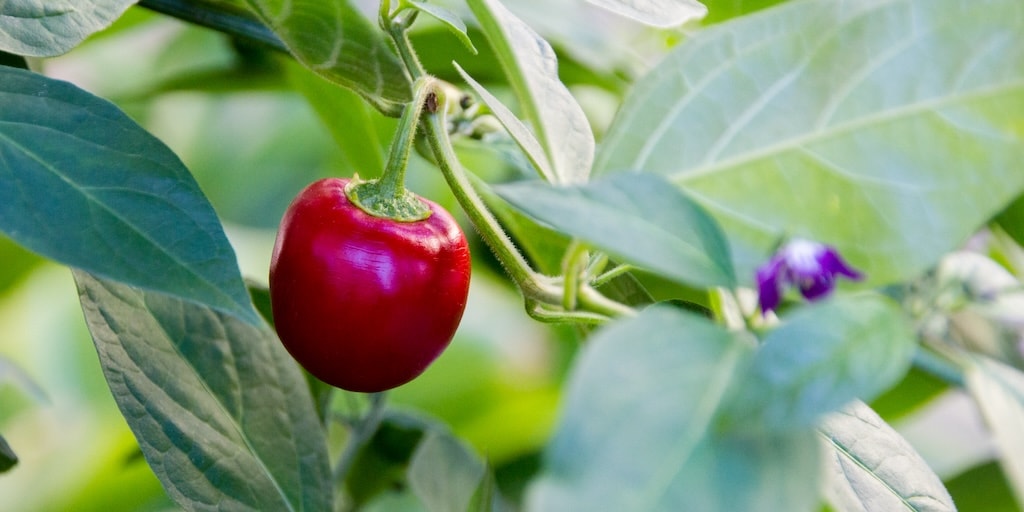Chillies are a diverse and fascinating group of plants that have been cultivated and migrated around the globe for centuries. There are five main domesticated species, each offering a unique flavour, leaf shape, flower colour and cultural history.
To help you choose the best varieties to grow in the UK, we asked chilli expert Rob Smith to summarise each of the five main types. For more inspiration, browse our full range of chilli seeds and potted chilli plants.
1. Capsicum Annuum

Image: Capsicum annuum ‘Mohawk’ from Dobies
Capsicum annuum is the most commonly grown species, encompassing a wide variety of chillies from sweet bell peppers to fiery cayennes.
- Taste: The taste ranges from sweet and mild (bell peppers) to hot and pungent (cayenne peppers).
- Flower and leaf shape: The flowers are typically white with five petals. Leaves are broad, green, and ovate, tapering to a point.
- Colours: Fruit colours include green, red, yellow, orange, and purple, depending on the variety.
- Origin and spread: Originating in Central and South America, Capsicum annuum has spread worldwide, becoming a staple in cuisines from Mexico to Asia. The Spanish and Portuguese explorers played a significant role in its global dissemination during the Age of Discovery.
- Interesting fact: Despite its species name ‘annuum’ which suggests an annual growth habit, many varieties are actually perennial in suitable climates.
2. Capsicum Frutescens

Image: Capsicum frutescens ‘Tabasco’ from Dobies
Capsicum frutescens is known for its small, fiery chillies, including the famous tabasco pepper.
- Taste: Typically very hot and pungent, with a sharp, intense heat.
- Flower and leaf shape: Flowers are white or greenish-white, often with a purple tinge. Leaves are smaller and narrower compared to C. annuum.
- Colours: Fruit colours range from green to red, and some varieties can be yellow or orange.
- Origin and spread: Native to the Amazon basin, Capsicum frutescens was spread throughout the Caribbean and Africa by European colonists and traders. It is a key ingredient in many African and Southeast Asian dishes.
- Interesting fact: The tabasco pepper is the primary ingredient in the famous Tabasco sauce, which undergoes a unique fermentation process.
3. Capsicum Chinense

Image: Capsicum chinense ‘Chocolate Habanero’ from Dobies
Capsicum chinense includes some of the hottest chillies in the world, like the habanero and the notorious ‘Carolina Reaper’.
- Taste: Known for their extreme heat and distinctive fruity or floral undertones.
- Flower and leaf shape: Flowers are typically white or greenish-white. Leaves are broad and glossy, often darker green compared to other species.
- Colours: Fruits can be a variety of colours, including green, yellow, orange, red, and even chocolate brown.
- Origin and spread: Despite the name suggesting Chinese origins, Capsicum chinense hails from the Amazon basin. It spread to the Caribbean, where it became a fundamental part of local cuisines.
- Interesting fact: The ‘Carolina Reaper’, a cultivar of C. chinense, holds the Guinness World Record for the hottest chilli pepper.
4. Capsicum Baccatum

Image: Chilli Pepper ‘Hot Lemon’ from Dobies
Capsicum baccatum includes varieties like the aji pepper, known for its distinct flavour and moderate heat.
- Taste: Typically sweet and fruity with varying levels of heat.
- Flower and leaf shape: Flowers are usually white with distinctive yellow or green spots. Leaves are large, green, and ovate.
- Colours: Fruits can be green, yellow, orange, or red.
- Origin and spread: Native to South America, particularly Peru and Bolivia, Capsicum baccatum is a staple in Peruvian cuisine and has spread to other parts of South America.
- Interesting fact: Aji peppers are an essential ingredient in traditional Peruvian dishes such as aji de gallina and ceviche.
5. Capsicum Pubescens

Image: Little Adventures/shutterstock
Capsicum pubescens is best known for the rocoto pepper, distinguished by its unique traits among chillies.
- Taste: Usually very hot with a fruity flavour.
- Flower and leaf shape: Flowers are purple, and leaves are hairy (hence “pubescens”).
- Colours: Fruits are typically red, orange, or yellow and have black seeds.
- Origin and spread: Native to the Andes region, particularly Bolivia and Peru. Capsicum pubescens has remained relatively localised but is highly valued in Andean cuisine.
- Interesting fact: Rocoto peppers are one of the oldest domesticated chilli species, with archaeological evidence dating back to 6,000 BC.
Growing different types of chillies at home not only adds spice to your garden, but also connects you to a rich tapestry of cultural histories and culinary traditions. Each species offers unique characteristics, from the blazing heat of Capsicum chinense to the fruity sweetness of Capsicum baccatum. Understanding these differences can help you choose the right varieties for your garden and kitchen, without the risk of blowing your head off!
Lead image: Chilli Pepper ‘Havanna Gold’ from Dobies

